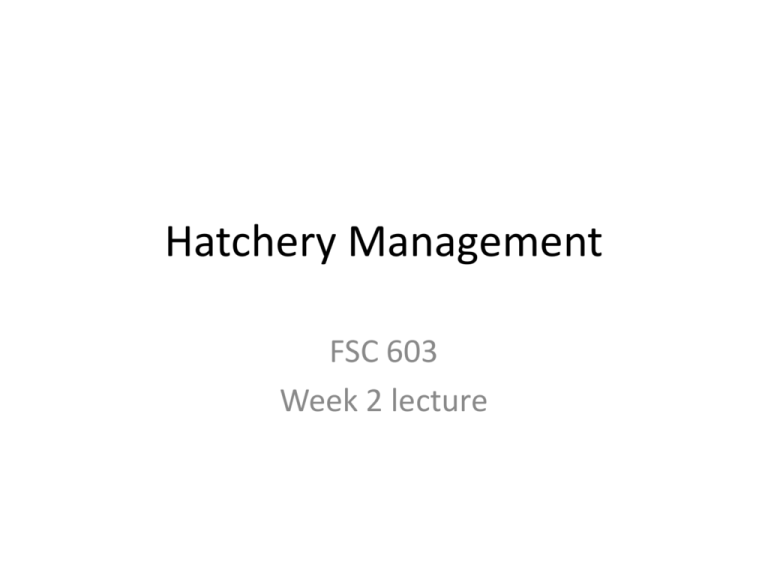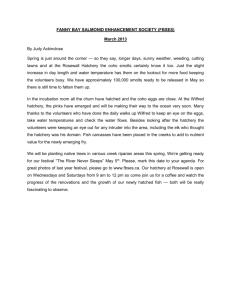week 2
advertisement

Hatchery Management FSC 603 Week 2 lecture What is a Hatchery? • A hatchery is a facility where eggs are incubated and hatched. • Many hatcheries also care for the young animals in their first few days or weeks of life, until they are healthy and old enough to be shipped to another location. Purpose of hatchery • There are several different types of hatchery in use around the world, and hatcheries may be established for numerous purposes, ranging from conservation to a need to create a stable food supply. • Some hatcheries handle fish such as salmon. • They collect, monitor, and incubate the eggs, using the young fish to stock ponds, streams, and fish farming operations. • The hatchery may be established for the purpose of increasing the population of an endangered species, or for supplying fish for sport, ornamentation, and food. • Fish hatcheries tend to specialize in a particular species. • The release of hatchery fish into the wild has been a controversial topic in some regions, with opponents arguing that the fish may cause problems in native fish populations, ranging from weakening genetic stock to spreading disease. Many salmon are bred in fish hatcheries. • Other hatcheries deal with poultry such as chickens, ducks, geese, and turkeys. • Poultry hatcheries often handle multiple species, using large incubators to incubate the eggs and protect the young in the early stages of their lives. • Some hatcheries breed birds for private consumers, such as fancy breeds of chicken kept by hobbyists, while others supply poultry to the agriculture industry. • Many large poultry farms have an attached hatchery which ensures that the supply of birds is consistent and steady. • Hatchery work can be demanding and very dirty. • The facilities are usually supervised by biologists or veterinarians or aqua-culturist who are familiar with animal husbandry, & they require a lot work on the ground every day. • Workers must ensure that the eggs are handled safely and properly, and that the young animals are provided with necessary nutrition, water, and clean facilities. • A full time hatchery may constantly have eggs in incubators at different stages of development along with young animals which require monitoring, and this necessitates a large staff. • People can also establish a hatchery in their own homes or small farms, using small incubators in a scaled-down version of the commercial hatchery. • Hatcheries are also sometimes used for educational purposes, as in classrooms where children learn about animal husbandry by hatching and raising chicks and fish. Chicks are hatched in a hatchery. Incubator (culture), a device used to grow and maintain microbiological cultures or cell cultures. What Makes an Ideal Hatchery? • Several characteristics are needed in the design of an ideal hatchery to ensure that the facility is safe, clean, and easy to use. • A well-designed hatchery will be more productive, with less risk of loss and more potential for raising additional stock as the hatchery's operations expand. • It should also comply with prevailing laws which relate to hatcheries and animal husbandry. • Hatcheries are used for the purpose of incubating the eggs of poultry and fish to hatch live young, and then raising the young until they are old enough to be sold or transported to another location. • Industrial hatcheries operate continuously, posing serious design challenges because they must house eggs and young at various stages of development. • The design considerations vary, depending on whether the facility is being used for poultry or fish. • In both cases, an ideal hatchery has excellent ventilation and a design which facilitates cleaning to keep the space as hygienic as possible. • It should include separate areas for incubating eggs and housing young to reduce the spread of disease, along with a secure area for storing feed, and an ample supply of fresh water. • An ideal hatchery also has clear protocols in place for workers, such as a ban on passing between the hatchery and brooding areas to keep these areas as separate as possible. • In the area where eggs are incubated and hatched, there needs to be plenty of space to move around, along with room to isolate different species or breeds. • In a poultry hatchery, different breeds may be incubated in separate incubators and trays, while in a fish hatchery, different ponds will be utilized to keep species separate. • The space should also be easy to monitor, so that staff can be alert to developing problems such as temperature fluctuations or impurities in the water. • In the brooding areas where young are taken out after they have hatched, cleanliness is critical. • High volumes of young animals can generate an astounding amount of waste, and this waste needs to be collected and disposed of responsibly. • Measures also need to be put in place for feeding and isolating animals to confirm that they are healthy before allowing them to mingle with the general population. • A processing area to get animals ready for shipment is also an important part of the design in an ideal hatchery. • Having space for the animals is obviously key in an ideal hatchery, but space for humans is needed as well. • Hatcheries need to keep extensive records on the animals they breed, which requires a lot of office space. • Many also need to provide some veterinary services, including basic services such as measuring and weighing young animals, and staffers also need a place to change, with some hatcheries having break rooms and shower areas as well. What is a Fish Hatchery? • A fish hatchery is a facility designed to raise fish. • It provides an optimum environment for fish eggs to develop and hatch by maintaining proper water temperature and oxygen levels, and providing adequate food supplies and safety from predators. • A fish hatchery works to raise baby fish and prepare them for release in another environment for various reasons, as well as for food. • Water environments that may be adequate for adult fish may not be sufficient for breeding, fish eggs and hatchlings. • Any number of environmental factors can cause adults to become infertile. • Fish eggs and baby fish are a favorite food for some predators like frogs, turtles and other fish. • Some adult fish even eat smaller fish and eggs of their own species. • Fish hatcheries resolve these problems. • One purpose of a fish hatchery is to raise a certain kind of fish in order to stock a lake or pond for fishing. • Certain types of fish, such as trout and salmon, are favorites among fisherman. • Sometimes, in a popular fishing hole, the fish are harvested too quickly to allow them to breed and grow. • A fish hatchery provides a safe haven until the fish are mature enough to be caught. Fish hatcheries may raise a certain kind of fish in order to stock a lake. • Another reason that a certain fish may be raised in a fish hatchery is for environmental conservation. • Every animal has its place in the ecosystem. • Sometimes, human activity makes it impossible for fish to breed or causes them to disappear from a body of water altogether. • A fish hatchery can reintroduce mature, healthy fish to a previously inhabited body of water where they will maintain the ecosystem by doing their part in the food chain. • A fish hatchery may also be used to farm fish for human food consumption. • Hatching and raising fish for food has many advantages for humans and the environment. • First, because of pollution, many wild fish are contaminated with dangerous pollutants such as mercury and polychlorinated biphenyls (PCBs). • Consuming these pollutants is hazardous to human health. • Farm raised fish contain lower levels of contaminants, which helps to reduce this risk. • Raising fish in a hatchery also helps to relieve the environmental pressures in an area due to over-fishing. • For people’s visual pleasure, a fish hatchery can raise fish such as koi or other carp and goldfish to be released into private or garden ponds. • Ornamental pond fish are hatched and cared for, then sold to consumers at garden centers and pet stores. • Similar to pond fish, tropical fish for aquariums can also be raised in a fish hatchery. Fish hatcheries might raise goldfish to sell to people for their ponds. A water feature containing ornamental fish.



